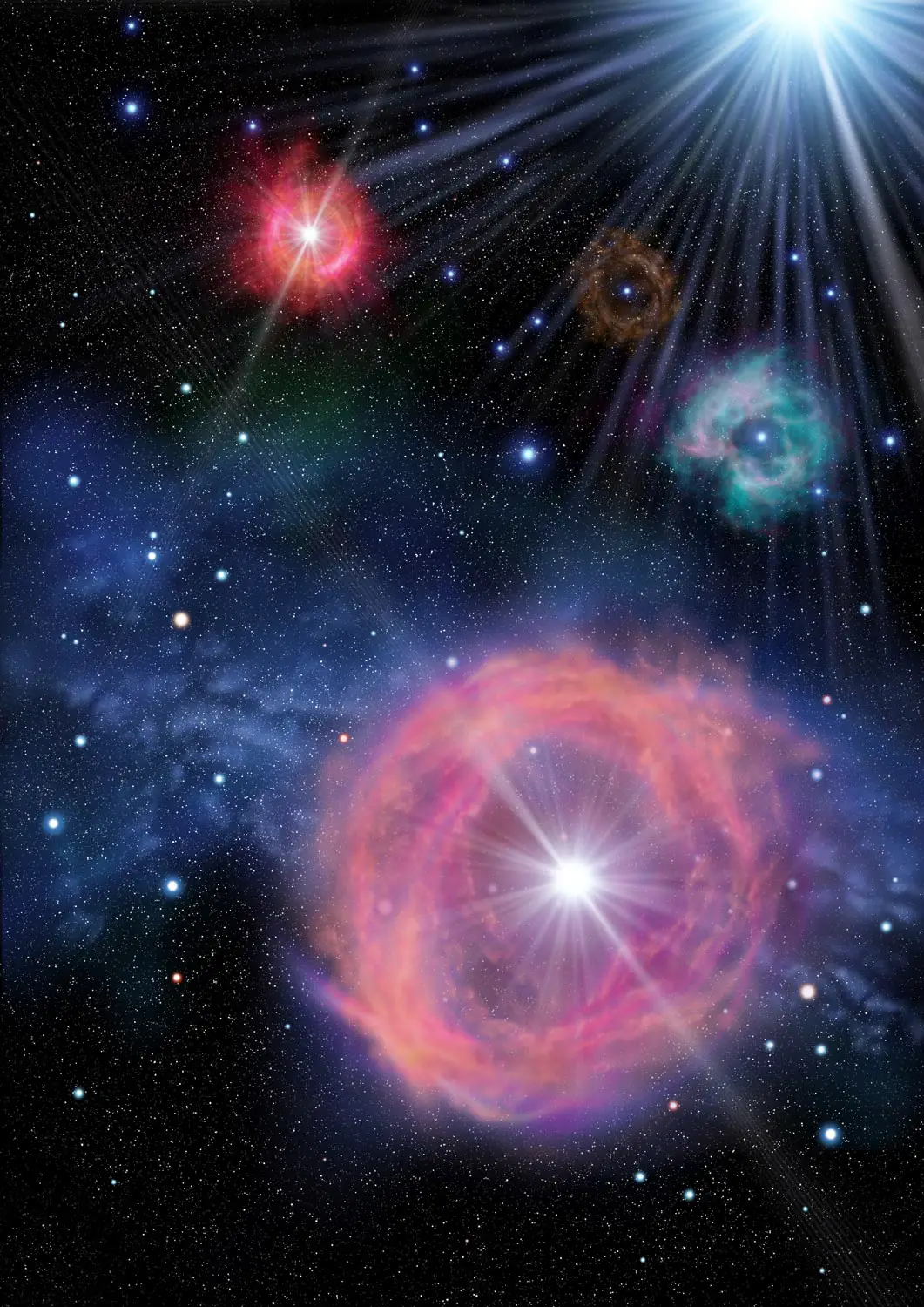Image credit: NAOC
In a groundbreaking discovery, scientists from the Chinese Academy of Sciences, along with international collaborators, have uncovered compelling evidence of Pair-Instability Supernovae (PISNe) originating from the Universe’s earliest stars. Their findings, recently published in Nature, offer crucial insights into the evolution of massive stars and the initial mass distribution in the early Universe.
During the Cosmic Dawn, the first stars emerged, dispelling the cosmic “dark ages” that followed the Big Bang. However, the distribution of their mass has remained an enigmatic puzzle in the realm of astrophysics.
Numerical simulations of the formation of these first stars have estimated their masses to be several hundred times that of our Sun. Among them, stars with masses ranging from 140 to 260 solar masses were believed to have undergone pair-instability supernovae (PISNe), a distinct phenomenon unlike ordinary supernovae (Type II and Type Ia supernovae). PISNe would have left behind a unique chemical signature in the atmospheres of subsequent generations of stars, but until now, no such evidence had been found.
Led by Prof. Gang Zhao from the National Astronomical Observatories of the Chinese Academy of Sciences (NAOC), a research team has identified a chemically peculiar star called LAMOST J1010+2358 in the Galactic halo, providing clear evidence for the existence of PISNe from the Universe’s very first massive stars. This discovery was made using data from the Large Sky Area Multi-Object Fiber Spectroscopic Telescope (LAMOST) survey, combined with follow-up high-resolution spectroscopic observations conducted with the Subaru Telescope. It has been confirmed that this star originated in a gas cloud enriched by the yields of a pair-instability supernova with a mass of 260 solar masses.
Collaborating with researchers from the Yunnan Observatories of the Chinese Academy of Sciences, the National Astronomical Observatory of Japan, and Monash University in Australia, the team has shed light on the chemical composition of LAMOST J1010+2358. Through high-resolution spectroscopic observations with the Subaru telescope, they have derived abundances for over ten elements. Notably, this star exhibits remarkably low levels of sodium and cobalt, with a sodium-to-iron ratio less than 1/100th of the solar value. Furthermore, there is a substantial disparity in the abundance of odd and even charge number elements, such as sodium/magnesium and cobalt/nickel.
“The peculiar odd-even variance, as well as the deficiencies of sodium and α-elements in this star, align with the predictions of primordial PISN from first-generation stars with a mass of 260 solar masses,” stated Dr. Qianfan Xing, the study’s first author.
The discovery of LAMOST J1010+2358 provides direct evidence of the hydrodynamical instability resulting from electron-positron pair production during the evolution of very massive stars. The creation of electron-positron pairs reduces thermal pressure within the core of such a star, leading to a partial collapse.
“This finding offers a crucial clue for constraining the initial mass function in the early universe,” emphasized Prof. Gang Zhao, the corresponding author of the study. “Prior to this research, no evidence of supernovae originating from such massive stars had been found among the metal-poor stars.”
Notably, the iron abundance of LAMOST J1010+2358 ([Fe/H] = -2.42) surpasses that of most metal-poor stars in the Galactic halo, suggesting that second-generation stars formed in gas dominated by PISNe might be more
Table of Contents
Frequently Asked Questions (FAQs) about Stellar Archaeology
What is Stellar Archaeology?
Stellar Archaeology is a field of research that investigates the chemical clues and remnants left behind by ancient stars. Scientists study these clues to understand the evolution of massive stars, uncover secrets of the early Universe, and explore phenomena like pair-instability supernovae.
What are Pair-Instability Supernovae (PISNe)?
Pair-Instability Supernovae (PISNe) are a type of supernova explosion that occurs in very massive stars. Unlike ordinary supernovae, PISNe are characterized by the production of electron-positron pairs, which leads to a partial collapse of the star’s core. The unique chemical signatures left by PISNe can provide valuable insights into the early Universe and the formation of subsequent generations of stars.
What is the significance of the discovery of LAMOST J1010+2358?
The discovery of LAMOST J1010+2358 is significant because it provides tangible evidence of the existence of Pair-Instability Supernovae from the Universe’s earliest stars. This star, found in the Galactic halo, exhibits a chemically peculiar composition consistent with the predictions of primordial PISNe. This discovery offers crucial insights into the initial mass function in the early Universe and the metallicity of second-generation stars.
How was the discovery made?
The discovery of LAMOST J1010+2358 was made using data from the Large Sky Area Multi-Object Fiber Spectroscopic Telescope (LAMOST) survey, combined with follow-up high-resolution spectroscopic observations conducted with the Subaru Telescope. By analyzing the star’s abundances for various elements, researchers identified its peculiar chemical composition and linked it to the existence of pair-instability supernovae from massive first-generation stars.
What are the implications of this research?
This research has significant implications for our understanding of the early Universe and the evolution of massive stars. The findings contribute to the knowledge of the initial mass distribution of first stars and provide crucial clues about the formation of subsequent generations of stars. Additionally, the discovery suggests that metal-poor stars formed in PISN-dominated gas may have higher metallicity than previously expected, challenging existing theories.
More about Stellar Archaeology
- Nature article: Stellar Archaeology: Chemical Clues Reveal Supernova Secrets From Universe’s First Massive Stars
- Chinese Academy of Sciences: Press Release
- National Astronomical Observatories of the Chinese Academy of Sciences (NAOC): Official Website
- Subaru Telescope: Official Website
- Yunnan Observatories of the Chinese Academy of Sciences: Official Website
- Monash University: Official Website


